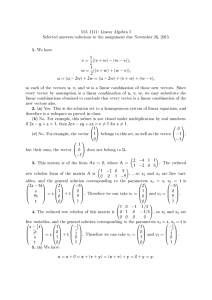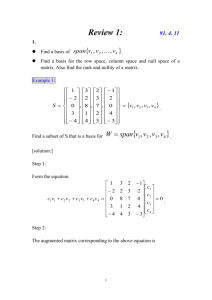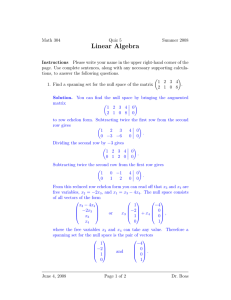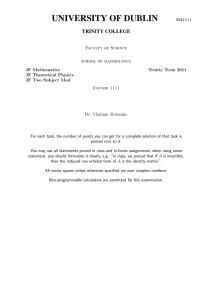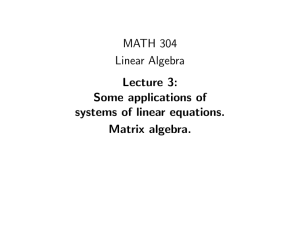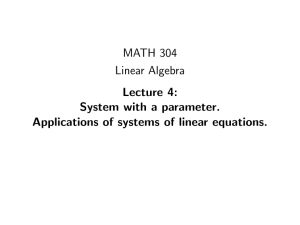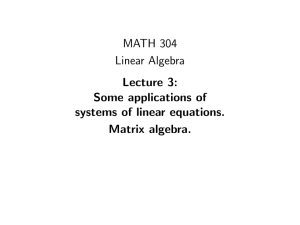MATH 323 Linear Algebra Lecture 3: Row echelon form (continued).
advertisement
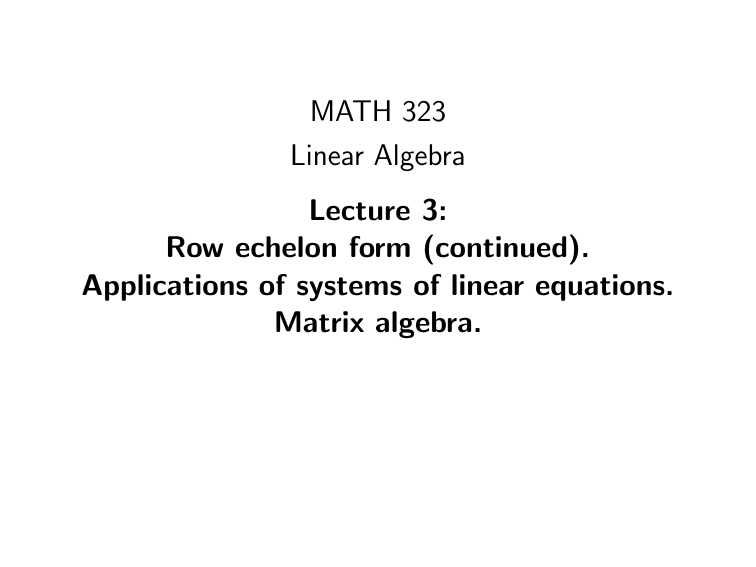
MATH 323 Linear Algebra Lecture 3: Row echelon form (continued). Applications of systems of linear equations. Matrix algebra. Row echelon form A matrix is in the row echelon form if the leading entries (equal to 1) shift to the right as we go from the first row to the last one. • • • • ∗ ∗ ∗ ∗ ∗ ∗ ∗ ∗ ∗ ∗ ∗ ∗ ∗ ∗ ∗ ∗ ∗ ∗ Leading entries are boxed; all the entries below the staircase line are zero; each step of the staircase has height 1; each circle marks a column without a leading entry. Theorem Any matrix can be converted into row echelon form by applying elementary row operations. Sketch of the proof: The proof is by induction on the number of columns in the matrix. It relies on the next lemma. Lemma Any matrix can be converted to one of the following forms using elementary row operations: (i) (1 a12 a13 . . . a1n ); 1 1 a12 . . . a1n 0 0 0 0 . .. . (ii) .. ; (iii) ... ; (iv) . B ; (v) . . . B 0 0 0 0 In the cases (i), (iii) and (v), we already have a row echelon form. In the cases (ii) and (iv), it is enough to convert the matrix B to row echelon form. Moreover, the row reduction on the block B can be simulated by applying elementary row operations to the entire matrix. Properties of row echelon form Let C be a matrix in the row echelon form (resp. reduced row echelon form). We say that C is a row echelon form (resp. reduced row echelon form) of a matrix A if C can be obtained from A by applying elementary row operations. Theorem 1 For any matrix, the reduced row echelon form exists and is unique. Theorem 2 Suppose A and B are matrices of the same dimensions. Then the following conditions are equivalent: (i) A and B share a reduced row echelon form; (ii) A and B share a row echelon form; (iii) A can be obtained from B by applying elementary row operations. Applications of systems of linear equations Problem 1. Find the point of intersection of the lines x − y = −2 and 2x + 3y = 6 in R2 . x − y = −2 2x + 3y = 6 Problem 2. Find the point of intersection of the planes x − y = 2, 2x − y − z = 3, and x + y + z = 6 in R3 . x −y = 2 2x − y − z = 3 x +y +z =6 Method of undetermined coefficients often involves solving systems of linear equations. Problem 3. Find a quadratic polynomial p(x) such that p(1) = 4, p(2) = 3, and p(3) = 4. Suppose that p(x) = ax 2 + bx + c. Then p(1) = a + b + c, p(2) = 4a + 2b + c, p(3) = 9a + 3b + c. a+b +c = 4 4a + 2b + c = 3 9a + 3b + c = 4 Method of undetermined coefficients often involves solving systems of linear equations. Problem 3. Find a quadratic polynomial p(x) such that p(1) = 4, p(2) = 3, and p(3) = 4. Alternative choice of coefficients: p(x) = ã + b̃x + c̃x 2. Then p(1) = ã + b̃ + c̃, p(2) = ã + 2b̃ + 4c̃, p(3) = ã + 3b̃ + 9c̃. ã + b̃ + c̃ = 4 ã + 2b̃ + 4c̃ = 3 ã + 3b̃ + 9c̃ = 4 Problem 4. Evaluate 0 x(x − 3) dx. 2 −1 (x − 1) (x + 2) Z To evaluate the integral, we need to decompose the rational x(x−3) function R(x) = (x−1) 2 (x+2) into the sum of simple fractions: R(x) = a b c + + 2 x − 1 (x − 1) x +2 = a(x − 1)(x + 2) + b(x + 2) + c(x − 1)2 (x − 1)2 (x + 2) = (a + c)x 2 + (a + b − 2c)x + (−2a + 2b + c) . (x − 1)2 (x + 2) a+c = 1 a + b − 2c = −3 −2a + 2b + c = 0 Traffic flow 450 400 610 640 520 600 Problem. Determine the amount of traffic between each of the four intersections. 450 400 x1 610 x4 520 640 x2 x3 600 x1 =?, x2 =?, x3 =?, x4 =? 450 610 A 400 x1 B x4 520 D 640 x2 x3 C 600 At each intersection, the incoming traffic has to match the outgoing traffic. Intersection A: x4 + 610 = x1 + 450 Intersection B: x1 + 400 = x2 + 640 Intersection C : x2 + 600 = x3 Intersection D: x3 = x4 + 520 x4 + 610 = x1 + 450 x1 + 400 = x2 + 640 x + 600 = x3 2 x3 = x4 + 520 −x1 + x4 = −160 x1 − x2 = 240 ⇐⇒ x − x3 = −600 2 x3 − x4 = 520 Electrical network 9 volts 4 ohms 1 ohm 3 ohms 2 ohms 4 volts Problem. Determine the amount of current in each branch of the network. i1 9 volts 4 ohms 1 ohm i2 3 ohms 2 ohms 4 volts i3 i1 =?, i2 =?, i3 =? i1 9 volts 4 ohms 1 ohm i2 3 ohms 2 ohms 4 volts i3 Kirchhof’s law #1 (junction rule): at every node the sum of the incoming currents equals the sum of the outgoing currents. 9 volts i1 4 ohms 1 ohm i2 A B 3 ohms 2 ohms 4 volts Node A: Node B: i3 i1 = i2 + i3 i2 + i3 = i1 Electrical network Kirchhof’s law #2 (loop rule): around every loop the algebraic sum of all voltages is zero. Ohm’s law: for every resistor the voltage drop E , the current i , and the resistance R satisfy E = iR. Top loop: Bottom loop: Big loop: 9 − i2 − 4i1 = 0 4 − 2i3 + i2 − 3i3 = 0 4 − 2i3 − 4i1 + 9 − 3i3 = 0 Remark. The 3rd equation is the sum of the first two equations. i1 = i2 + i3 9 − i2 − 4i1 = 0 4 − 2i3 + i2 − 3i3 = 0 i1 − i2 − i3 = 0 ⇐⇒ 4i1 + i2 = 9 −i2 + 5i3 = 4 Matrices (revisited) Definition. An m-by-n matrix is a rectangular array of numbers that has m rows and n columns: a11 a12 a 21 a22 .. .. . . am1 am2 . . . a1n . . . a2n . . . ... . . . amn Notation: A = (aij )1≤i≤n, 1≤j≤m or simply A = (aij ) if the dimensions are known. An n-dimensional vector can be represented as a 1 × n matrix (row vector) or as an n × 1 matrix (column vector): x1 x 2 (x1, x2, . . . , xn ) .. . xn An m × n matrix A = (aij ) can be regarded as a column of n-dimensional row vectors or as a row of m-dimensional column vectors: v1 v 2 A = .. , vi = (ai1 , ai2, . . . , ain ) . vm a1j a 2j A = (w1, w2, . . . , wn ), wj = .. . amj Vector algebra Let a = (a1, a2, . . . , an ) and b = (b1, b2, . . . , bn ) be n-dimensional vectors, and r ∈ R be a scalar. Vector sum: a + b = (a1 + b1, a2 + b2, . . . , an + bn ) Scalar multiple: Zero vector: r a = (ra1, ra2, . . . , ran ) 0 = (0, 0, . . . , 0) Negative of a vector: −b = (−b1, −b2, . . . , −bn ) Vector difference: a − b = a + (−b) = (a1 − b1, a2 − b2 , . . . , an − bn ) Given n-dimensional vectors v1 , v2, . . . , vk and scalars r1, r2, . . . , rk , the expression r 1 v1 + r 2 v2 + · · · + r k vk is called a linear combination of vectors v1 , v2 , . . . , vk . Also, vector addition and scalar multiplication are called linear operations. Matrix algebra Definition. Let A = (aij ) and B = (bij ) be m×n matrices. The sum A + B is defined to be the m×n matrix C = (cij ) such that cij = aij + bij for all indices i , j. That is, two matrices with the same dimensions can be added by adding their corresponding entries. a11 + b11 a12 + b12 b11 b12 a11 a12 a21 a22 + b21 b22 = a21 + b21 a22 + b22 a31 + b31 a32 + b32 b31 b32 a31 a32 Definition. Given an m×n matrix A = (aij ) and a number r , the scalar multiple rA is defined to be the m×n matrix D = (dij ) such that dij = raij for all indices i , j. That is, to multiply a matrix by a scalar r , one multiplies each entry of the matrix by r . ra11 ra12 ra13 a11 a12 a13 r a21 a22 a23 = ra21 ra22 ra23 ra31 ra32 ra33 a31 a32 a33 The m×n zero matrix (all entries are zeros) is denoted Omn or simply O. Negative of a matrix: −A is defined as (−1)A. Matrix difference: A − B is defined as A + (−B). As far as the linear operations (addition and scalar multiplication) are concerned, the m×n matrices can be regarded as mn-dimensional vectors. Examples 3 A= 1 2 C = 0 2 −1 2 0 1 , B= , 1 1 0 1 1 0 1 1 , D= . 1 0 1 5 2 A+B = 1 2 4 0 2C = , 0 2 7 2C + 3D = 0 0 , 2 3D = 3 , 5 A−B = 1 2 −2 , 1 0 0 3 3 , 0 3 A + D is not defined.
